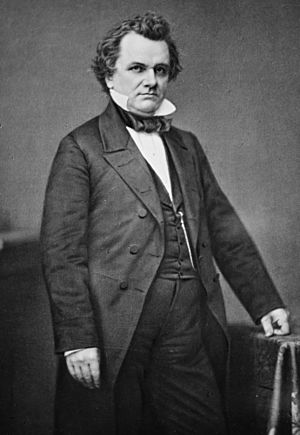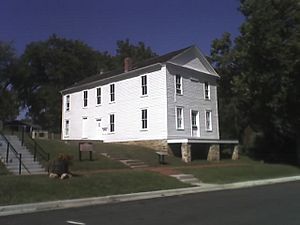Lecompton Constitution facts for kids
The Lecompton Constitution was a plan for how the state of Kansas would be governed. It was written in 1857 by people who wanted to allow slavery in Kansas. This plan also said that free Black people could not have the same rights as others.
However, on January 4, 1858, most voters in the Kansas Territory said "no" to the Lecompton Constitution. They rejected it! This rejection, and Kansas later becoming a free state (meaning no slavery), showed that there had been a lot of unfair and dishonest voting in earlier attempts to make Kansas a slave state. These unfair practices were often done by groups like the bushwhackers and border ruffians.
Before the Lecompton Constitution, there was another plan called the Topeka Constitution. After Lecompton, came the Leavenworth and Wyandotte plans. The Wyandotte Constitution was the one that finally became the official state constitution for Kansas.
Why Was It Created?
The Lecompton Constitution was made to go against the 1855 Topeka Constitution. The Topeka plan was written by James H. Lane and other "free-state" people, who were against slavery.
Most of the people in the Kansas government at that time were slave owners. They met in September 1857 in Lecompton, which was chosen as the capital. Their goal was to write a new plan that would allow slavery and compete with the anti-slavery Topeka Constitution.
Most of the actual settlers in Kansas were against slavery. Because of this, they decided not to vote on the Lecompton Constitution. This was a way of protesting.
The governor of Kansas at the time, Robert J. Walker, actually supported slavery. But even he thought the Lecompton Constitution was very unfair. He quit his job as governor so he wouldn't have to make people follow it.
The President's Role

President James Buchanan was a big supporter of slavery. So, when the Lecompton Constitution was sent to the U.S. Congress, he supported it. He had the backing of many politicians from the Southern states, who also wanted slavery to spread.
However, many politicians from the Northern states, led by a powerful senator named Stephen A. Douglas, voted against the constitution. They joined with the Republican Party (who were against slavery) to defeat it.
Related Pages
- The Kansas Constitution on Wikisource.


